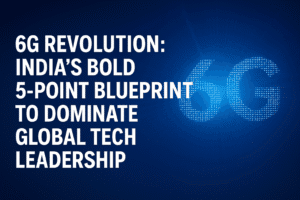6G Revolution: India’s Bold 5-Point Blueprint to Dominate Global Tech Leadership
Union Minister Jyotiraditya Scindia has declared India’s ambition to spearhead global regulations for 6G technology, building on its rapid 5G rollout that now covers 82% of the population across 99% of districts within just 22 months. This milestone underscores India’s growing influence in shaping next-gen connectivity, prioritizing inclusive access and rural empowerment. Simultaneously, the nation is modernizing its 165,000-strong India Post network into a digital-age logistics hub, bridging urban-rural gaps through e-commerce and financial services.
Scindia also highlighted public-driven boycotts of Türkiye and Azerbaijan, reflecting citizen sentiment on national security, while reaffirming India’s commitment to blending technological sovereignty with grassroots infrastructure. By championing 6G innovation, revamping legacy systems, and aligning policy with public resolve, India aims to balance global tech leadership with equitable growth, ensuring its digital revolution benefits both its citizens and the world.

6G Revolution: India’s Bold 5-Point Blueprint to Dominate Global Tech Leadership
In a bold declaration signaling India’s growing influence in global technology governance, Union Minister Jyotiraditya Scindia announced the nation’s intent to spearhead the development of 6G regulatory frameworks. Speaking on World Telecommunication and Information Society Day (May 17), Scindia emphasized India’s pivotal role in shaping the next generation of connectivity, underscoring its rapid strides in 5G deployment and the modernization of its historic postal network.
India’s 5G Success Sets the Stage for 6G Leadership
Scindia highlighted the unprecedented speed of India’s 5G rollout, which has reached 82% of the population across 99% of districts within just 22 months—a feat unmatched in scale and efficiency. This acceleration, he noted, positions India as a critical player in drafting the rules for 6G, a technology poised to revolutionize industries through advanced AI integration, ultra-low latency, and immersive applications. By leading regulatory discussions, India aims to ensure that 6G standards align with its socio-economic priorities, such as affordable access and rural connectivity, while fostering global collaboration.
Experts suggest that India’s proactive stance could help bridge the digital divide by advocating for inclusive policies. “Dominating 6G regulation isn’t just about technological prowess; it’s about ensuring equitable growth,” said a telecom analyst. “India’s experience in scaling digital infrastructure makes it a credible voice.”
India Post: A Legacy Network Reinvented for the Digital Age
Beyond telecom, Scindia spotlighted the transformation of India Post, one of the world’s largest postal networks, into a modern logistics powerhouse. With 164,000 post offices and 250,000 employees, the service is expanding into e-commerce delivery, banking, and last-mile connectivity—critical for rural India. The minister also reflected on his 2008 redesign of India Post’s logo, reinforcing its ethos of “Postal Service is Public Service.” Today, this network is pivotal in bridging urban-rural gaps, delivering everything from government subsidies to online purchases.
Public Sentiment Shapes Foreign Policy Stance
Addressing recent citizen-led boycotts against Türkiye and Azerbaijan for their perceived support of Pakistan during Operation Sindoor (details of which remain classified), Scindia framed these actions as grassroots expressions of patriotism. “When national security is at stake, the people’s will is paramount,” he stated, acknowledging the emotional yet strategic impact of public sentiment on diplomatic relations. This episode underscores a broader trend of civic activism influencing India’s foreign policy discourse.
Challenges and Strategic Vision
While India’s ambitions are clear, challenges persist. Developing 6G domestically requires heavy R&D investment and collaboration between academia, industry, and government. Critics point to hurdles like spectrum allocation and global competition from tech giants. However, initiatives like the Bharat 6G Alliance and the government’s ₹10,000 crore (approx. $1.2 billion) 6G roadmap signal serious intent.
Conclusion: A Multifaceted Approach to Global Leadership
India’s dual focus on cutting-edge tech and grassroots infrastructure modernization reflects a holistic vision for digital sovereignty. By leveraging its 5G success, revamping legacy systems like India Post, and respecting public sentiment in geopolitics, the nation is crafting a unique blueprint for global leadership. As Scindia asserted, “The telecom revolution is not just about connectivity—it’s about empowering every citizen and asserting our role on the world stage.”
In the coming years, India’s ability to balance innovation with inclusivity will determine its success in shaping a 6G era that benefits both its population and the global community.
You must be logged in to post a comment.